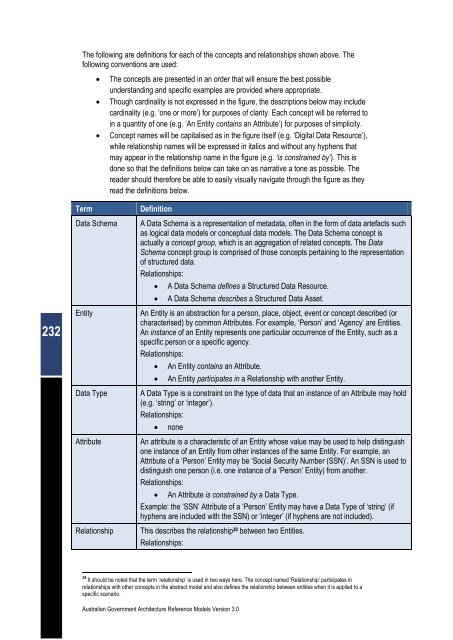Australian Government Architecture Reference Models Version 3.0
Australian Government Architecture Reference Models Version 3.0
Australian Government Architecture Reference Models Version 3.0
You also want an ePaper? Increase the reach of your titles
YUMPU automatically turns print PDFs into web optimized ePapers that Google loves.
232<br />
The following are definitions for each of the concepts and relationships shown above. The<br />
following conventions are used:<br />
� The concepts are presented in an order that will ensure the best possible<br />
understanding and specific examples are provided where appropriate.<br />
� Though cardinality is not expressed in the figure, the descriptions below may include<br />
cardinality (e.g. ‘one or more’) for purposes of clarity. Each concept will be referred to<br />
in a quantity of one (e.g. ‘An Entity contains an Attribute’) for purposes of simplicity.<br />
� Concept names will be capitalised as in the figure itself (e.g. ‘Digital Data Resource’),<br />
while relationship names will be expressed in italics and without any hyphens that<br />
may appear in the relationship name in the figure (e.g. ‘is constrained by’). This is<br />
done so that the definitions below can take on as narrative a tone as possible. The<br />
reader should therefore be able to easily visually navigate through the figure as they<br />
read the definitions below.<br />
Term Definition<br />
Data Schema<br />
Entity<br />
Data Type<br />
Attribute<br />
Relationship<br />
A Data Schema is a representation of metadata, often in the form of data artefacts such<br />
as logical data models or conceptual data models. The Data Schema concept is<br />
actually a concept group, which is an aggregation of related concepts. The Data<br />
Schema concept group is comprised of those concepts pertaining to the representation<br />
of structured data.<br />
Relationships:<br />
� A Data Schema defines a Structured Data Resource.<br />
� A Data Schema describes a Structured Data Asset.<br />
An Entity is an abstraction for a person, place, object, event or concept described (or<br />
characterised) by common Attributes. For example, ‘Person’ and ‘Agency’ are Entities.<br />
An instance of an Entity represents one particular occurrence of the Entity, such as a<br />
specific person or a specific agency.<br />
Relationships:<br />
� An Entity contains an Attribute.<br />
� An Entity participates in a Relationship with another Entity.<br />
A Data Type is a constraint on the type of data that an instance of an Attribute may hold<br />
(e.g. ‘string’ or ‘integer’).<br />
Relationships:<br />
� none<br />
An attribute is a characteristic of an Entity whose value may be used to help distinguish<br />
one instance of an Entity from other instances of the same Entity. For example, an<br />
Attribute of a ‘Person’ Entity may be ‘Social Security Number (SSN)’. An SSN is used to<br />
distinguish one person (i.e. one instance of a ‘Person’ Entity) from another.<br />
Relationships:<br />
� An Attribute is constrained by a Data Type.<br />
Example: the ‘SSN’ Attribute of a ‘Person’ Entity may have a Data Type of ‘string’ (if<br />
hyphens are included with the SSN) or ‘integer’ (if hyphens are not included).<br />
This describes the relationship 38 between two Entities.<br />
Relationships:<br />
38 It should be noted that the term ‘relationship’ is used in two ways here. The concept named ‘Relationship’ participates in<br />
relationships with other concepts in the abstract model and also defines the relationship between entities when it is applied to a<br />
specific scenario.<br />
<strong>Australian</strong> <strong>Government</strong> <strong>Architecture</strong> <strong>Reference</strong> <strong>Models</strong> <strong>Version</strong> <strong>3.0</strong>

















